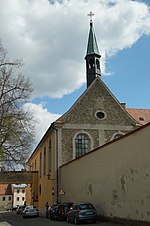Scots Monastery, Regensburg

The Scots Monastery (in German Schottenkirche, Schottenkloster or Schottenstift) is the former Benedictine Abbey of St James (Jakobskirche) in Regensburg, Germany. It was founded in the 11th century by Irish missionaries and for most of its history was in the hands of first Irish, then Scottish monks. In Middle Latin, Scotti meant Gaels, not differentiating Ireland from Scotland, so that the term Schottenstift dates from the Irish period. The full official name of the actual church, the most prominent building within the abbey complex, is Die irische Benediktinerklosterkirche St. Jakob und St. Gertrud (literally: "The Irish Benedictine Abbey Church of St. James and St. Gertrude").
Excerpt from the Wikipedia article Scots Monastery, Regensburg (License: CC BY-SA 3.0, Authors, Images).Scots Monastery, Regensburg
Jakobstraße, Regensburg Altstadt
Geographical coordinates (GPS) Address External links Nearby Places Show on map
Geographical coordinates (GPS)
| Latitude | Longitude |
|---|---|
| N 49.018611111111 ° | E 12.088333333333 ° |
Address
Schottenkirche St. Jakob
Jakobstraße 3
93047 Regensburg, Altstadt
Bavaria, Germany
Open on Google Maps











